 |
||
|
||
| ||
This is the last hard drive roundup this year. The leading manufacturers have released quite a lot of new models, it is only IBM Deskstar 120GXP which is still lacking, but this model will likely to appear only by the end of January. So, here is what we have today. Maxtor 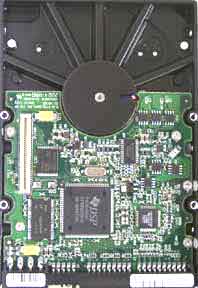 Maxtor D540X-4D The D540X line has in fact two models - of Maxtor and Quantum. The Maxtor's model marked with "D" is more popular, therefore it was chosen to be tested in our lab. A standard Maxtor's case and a signal processor (DSP) are the distinguishing features of this model. The Maxtor Data Protection System and Shock Protection System, as well as the Acoustic Management System, are provided. The line consists of 20, 40, 60 and 80 GB drives. The record density is 40 GB per platter; a spindle speed is 5400 rpm. We tested a 80 GB drive.  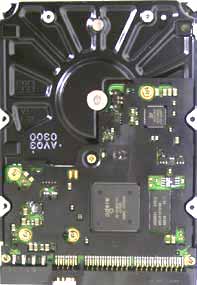 Maxtor D740X-6L The photo shows a model developed by Quantum. As you can see, it looks entirely different. The most important innovation is Ultra ATA/133 interface. It is the only model with 7200 rpm speed which supports this protocol. Anyway, the only model with a speed of 5400 rpm with Ultra ATA/133 support is produced by Maxtor. Here we have Maxtor Data Protection System and Shock Protection System. The line includes 20, 40, 60 and 80 GB drives with a record density of 40 GB per platter. We tested the most sizeable model. Samsung 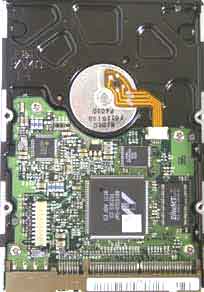 Samsung SP8004H The SP8004H is a drive with a spindle speed of 7200 rpm. Its record density is 40 GB per platter and a buffer of 2 MB. The line has 20, 40 and 80 GB models, and we tested 40 GB and 80 GB ones. Western Digital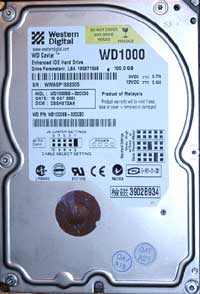 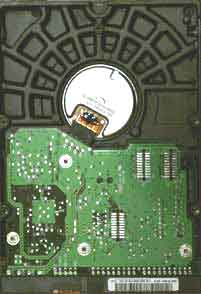 Western Digital Caviar 1000BB The WD Caviar 1000BB is the largest drive in our lab. This drive has a nonstandard record density: 3 platters and 6 heads instead of 5 heads as it should be with 40 GB density and a size of 100 GB. Probably the engineers think that 2 heads per platter are better; their Caviar 1200BB drive of 120 GB in size has the same combination, and its record density is 40 GB per platter. One more WD's drive we have is WD Caviar 800BB; it also has three platters and six heads. The complete characteristics of the drives can be found in this table, and now we are moving to the tests. TestsIn this test we decided to extend our testing technique by including the HD Tach 2.61 program. First of all, it measures an average read/write speed to/from platter, which is quite an interesting parameter. Secondly, it is interesting to compare access times and CPU utilization values obtained in different tests. Besides, the only controller I had at the time of the tests - ATA/133, was integrated into a mainboard, so I had to carry out the tests on another testbed:
Well, it is not very good, but I think that the results depend mainly on a chipset and the HPT372 controller. Furthermore, as the Maxtor D740X was developed by Quantum, changing of an acoustic level with the AMSET utility doesn't affect an access time, and therefore, test results. Probably, integration of the Maxtor Acoustic Management technology into the Quantum product wasn't successful. And now let's turn to the results (since the scores of both Samsung drives are very close we publish only those of the SP8004H). The diagrams also show the results of discs with a recording density of 40 GB per platter. Access time and CPU utilization – 7200 rpm
|
|
Article navigation: |
| blog comments powered by Disqus |
| Most Popular Reviews | More RSS |
 |
Comparing old, cheap solutions from AMD with new, budget offerings from Intel.
February 1, 2013 · Processor Roundups |
 |
Inno3D GeForce GTX 670 iChill, Inno3D GeForce GTX 660 Ti Graphics Cards A couple of mid-range adapters with original cooling systems.
January 30, 2013 · Video cards: NVIDIA GPUs |
 |
Creative Sound Blaster X-Fi Surround 5.1 An external X-Fi solution in tests.
September 9, 2008 · Sound Cards |
 |
The first worthwhile Piledriver CPU.
September 11, 2012 · Processors: AMD |
 |
Consumed Power, Energy Consumption: Ivy Bridge vs. Sandy Bridge Trying out the new method.
September 18, 2012 · Processors: Intel |
| Latest Reviews | More RSS |
 |
Retested all graphics cards with the new drivers.
Oct 18, 2013 · 3Digests
|
 |
Added new benchmarks: BioShock Infinite and Metro: Last Light.
Sep 06, 2013 · 3Digests
|
 |
Added the test results of NVIDIA GeForce GTX 760 and AMD Radeon HD 7730.
Aug 05, 2013 · 3Digests
|
 |
Gainward GeForce GTX 650 Ti BOOST 2GB Golden Sample Graphics Card An excellent hybrid of GeForce GTX 650 Ti and GeForce GTX 660.
Jun 24, 2013 · Video cards: NVIDIA GPUs
|
 |
Added the test results of NVIDIA GeForce GTX 770/780.
Jun 03, 2013 · 3Digests
|
| Latest News | More RSS |
Platform · Video · Multimedia · Mobile · Other || About us & Privacy policy · Twitter · Facebook
Copyright © Byrds Research & Publishing, Ltd., 1997–2011. All rights reserved.